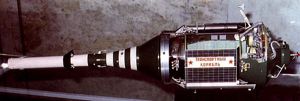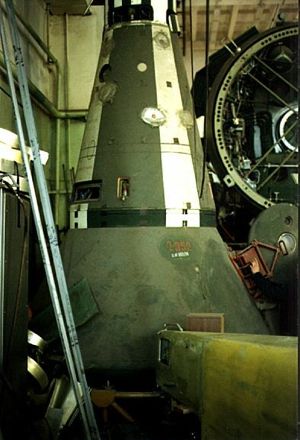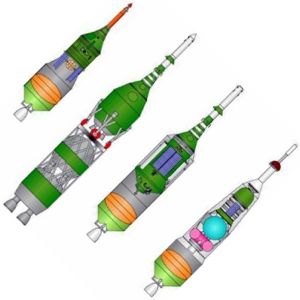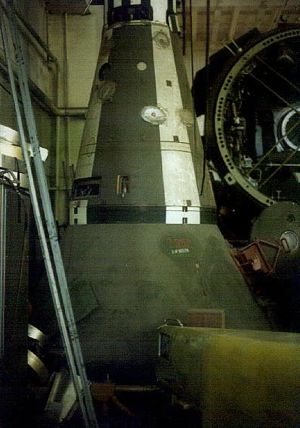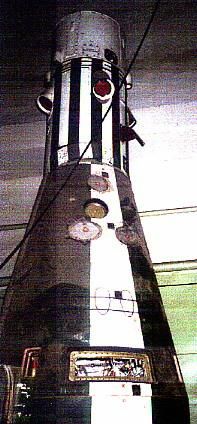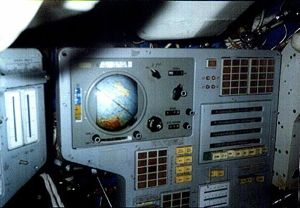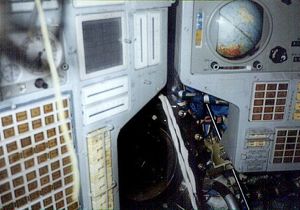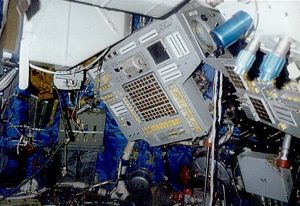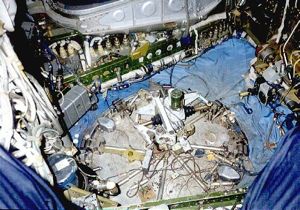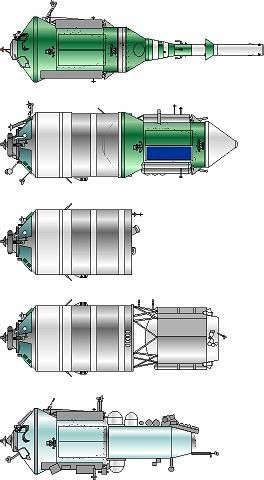
Home - Search - Browse - Alphabetic Index: 0- 1- 2- 3- 4- 5- 6- 7- 8- 9
A- B- C- D- E- F- G- H- I- J- K- L- M- N- O- P- Q- R- S- T- U- V- W- X- Y- Z
TKS
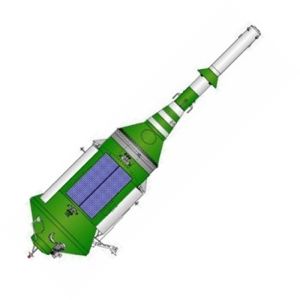 TKS Manned Ferry TKS manned space station ferry. Credit: © Mark Wade |
AKA: 11F72;TKS-M;Transportniy Korabl Snabzheniya. Status: Operational 1977. First Launch: 1977-07-17. Last Launch: 1985-09-27. Number: 4 . Payload: 12,600 kg (27,700 lb). Thrust: 7.84 kN (1,763 lbf). Gross mass: 17,510 kg (38,600 lb). Unfuelled mass: 13,688 kg (30,176 lb). Specific impulse: 291 s. Height: 17.51 m (57.44 ft). Span: 17.00 m (55.00 ft).
The initial Almaz program planned in 1965 consisted of two phases. In the second phase sustained operations would be conducted with Almaz dual-docking port stations serviced by TKS manned resupply vehicles. After many delays, second phase flights of Almaz-2 stations and the TKS were to be flown in 1981-1982. Unmanned flight tests of the TKS, its VA re-entry capsule, and construction of dual-port Almaz stations were completed, but Phase 2 was cancelled in 1979. The three TKS already built were instead flown unmanned to civilian Salyut space stations in 1981-1985.
On 1 January 1965 a decree of the Central Committee of the Communist Party and Council of Soviet Ministers was issued: 'On work on space stations at OKB-52'. This defined Almaz as an OOS - Manned Orbital Station - in specific reply to the USAF Manned Orbiting Laboratory program. The draft project for the phase 2 RKK-B station, with three crew, was to be completed by 21 June 1967. The Almaz RKK-B / OPS+TKS was designed for a minimum one year active life. Crews would be rotated by the TKS ferry spacecraft to the OPS. Both the OPS and TKS would be equipped with VA re-entry capsules. The TKS ferry came in at 17.5 metric tons and 45 cubic meters. The OPS and TKS were each equipped with a VA re-entry capsule, with a mass of 4.2 metric tons each. The complete complex provided a grand total of 89.4 cubic meters of habitable volume for six crew. The TKS had enough guidance, consumables, and electricity to dock dozens of times with the station. It could also maneuver independently. The VA capsules were designed for ten reuses.
Three to four dockings of the TKS would rotate crews and bring fresh supplies to the station. Phase B was to last 5 to 6 years. Following many revisions to the Almaz phase one program, Chelomei was finally able to obtain a formal go-ahead for development of the TKS ferry. This was contained in a 16 June 1970 Decree 437-160 'On creation of the TKS and termination of the 7K-TK'. It was finally agreed that for Almaz phase 2 the Soyuz 7K-TK would be replaced by Chelomei's own TKS transport-supply spacecraft. This would consist of the 11F74 VA landing capsule (designed for the original one-launch Almaz station design), together with a new 11F77 functional-cargo block (FGB). The TKS would transport three crew and sufficient supplies for 90 days operation of the Almaz. TKS design was to be completed in fourth quarter 1972.
Design work began on the TKS had actually begun in 1969. To assure reliability all systems were qualification tested on dynamic, static, heat, and flammability test stands. These included complete ECS, docking, rendezvous, and electrical analogue system tests. At Zagorsk test stands were built for the payloads, engine tests, and vacuum trials. At Chkalovsk ECS and thermo-regulation system trial were conducted. Full scale stand was built for testing of the docking system as well as a full scale VA.
At this time development of Almaz Phase 2 seemed uncertain. The official plan was that Almaz would be succeeded by Mishin's enormous MKBS space base. However TKS was preserved as the ferry for MKBS. This was reiterated by Afanasyev in a reply to a joint letter from Chief Designers Mishin and Chelomei of 3 February 1972.
Chelomei was so enraged with Mishin's delays in qualifying the Soyuz for phase 1 Almaz and its marginal technical characteristics that he sent a letter to the Soviet leadership on 28 February 1973. In this he complained that the 7K-T did not have the propulsive capability for multiple docking attempts with Almaz; did not have the docking equipment and necessary backups systems to guarantee crew safety in all flight modes; did not have the capability to provide full function unless recharged by the OPS for 2 to 3 days after docking. Therefore he recommended that Almaz should be unmanned (!) for Phase I flights until the TKS was available. Chelomei's recommendation was not taken up.
Following three successful Skylab missions came the shocking news that Mishin had been authorized to build a new-design fifth DOS station using Almaz facilities. Chelomei wrote a bitter letter to Afanasyev on 28 December 1973. He noted that the K-00534 TTT requirements for Almaz of the Ministry of Defense envisioned a two phase program. Instead his Khrunichev ZIKh factory was hijacked for DOS production. Now it had been further assigned to build DOS-5 for Mishin. He asked Afanasyev how to resolve this situation.
It was clear that the phased development plan for Almaz was wrecked. Therefore a decision had to be made as to how to develop the VA re-entry capsule for Almaz-2 and TKS. V A Ozertskovskiy, head of section test, defined the generic parameters for VA development. Flight trials would be necessary to develop the SAS abort system to pull the VA away from the Proton rocket in case of an emergency situation. Therefore it was suggested that one Proton launch would handle two VA's in the 82LB72 configuration. This plan was approved in 1974. Two VA's were enclosed in a cylindrical housing called the LVI. The external geometry of the 82LB2 was exactly the same as the TKS' FGB+VA. Originally two launches of two pairs of capsules were planned: VA#030 (technology article) with analogue #009 in 1975, to be followed by VA 009A with SAS and 009 analogue inside the shroud in 1976.
Fifty articles of the VA were built for development, including articles for development test stands, hatch tests, static test, and drop test, static and dynamic test, medical article #004, and those for development of the ADU rocket unit of the SAS abort system. From 1974-1977 five launches were undertaken from area 51 at Baikonur of the SAS system (three using VA #005, two using VA #007). These were attached to a complete mock-up of the FGB including the hatch tunnel and connector umbilical. When the 'Abort' command was sent, the 86 metric ton thrust motor of the ADU pulled the VA capsule away from the pad. 10 seconds from the abort command the ADU/TUD/NO separated and the landing systems went into operation. The braking parachute deployed for seven seconds, followed by the main chute with 1770 square meters of area. The capsule made a soft landing 2 km away. All five tests went well.
Phase 1 Almaz flight were finally underway as Salyut 3 and 5. Meanwhile Phase 2 of the Almaz project continued, with the Central Committee of the Communist Party and Council of Soviet Ministers Decree 476-13 'On course of work on Almaz and the TKS' being issued on 19 January 1976. Six full-up TKS flight spacecraft were originally planned, together with nine separate unpiloted launches of the VA capsule. Two unmanned TKS flights would be followed by four manned missions (later changed to five manned flights). The decree set forth the following program for completion of Almaz Phase 1 and Phase 2:
- First quarter 1976 - Unmanned flight tests of VA capsule
- Second quarter 1976 - Completion of draft project of OPS with two docking ports for service by rotating crews
- End 1976 - Unmanned flight tests of TKS
- End 1977 - End of Phase 1 with flight of OPS-3
- End 1977 - First flight test of OPS-4 with two docking ports with return capsule on front port
- End 1978 - Manned TKS flights
- End 1980 - Acceptance into service of OPS/TKS/VA systems
However soon after this decree was issued Marshal Grechko suffered a heart attack. With this Chelomei lost his most active patron and was unable to withstand the slow strangulation of his projects by Ustinov and Glushko.
VA capsules would be tested two at a time in the special 82LB72 Proton booster configuration. The original two-launch program had been expanded to five launches of two capsules in the LVI housing. The last two launches in 1978 were to be manned.
The VA capsule had a hypersonic lift to drag ratio of 0.25, allowing it to generate lift during re-entry. This allowed the BSU-V manned capsule guidance system to maneuver the spacecraft to its landing point using the optimum path for minimal heating and G-forces. The reusable heat shield material developed for the VA was far superior to that used on the Soyuz capsule and was used as well on Chelomei's K-1 and LKS manned spacecraft designs. The SAS system abort system for the VA separated the capsule with 15 G's of acceleration from the booster in case of a malfunction and soft landed the capsule 1.0-1.5 km from the launch pad. In the lab the 92-2 LVI mock-up was used to test automatic systems, conduct trials tests, use of the TDU engine at the center of mass, hermetic sealing of the LVI section, and separation of the DU.
10 December 1976 the first Proton 82LB72 VA test vehicle was placed on the pad. The VA capsules included the Probki radioactive sensor system within the Kaktus gamma ray altimeter, which set off the DU braking unit for a soft landing of the capsule. In place of space suits telemetry equipment was installed.
Launch of mission LVI-1 came at 04:00 on 15 December. Both capsules were recovered at 44 deg N, 73 deg E, on December 15, 1976 3:00 GMT. The flights were officially given the designations Cosmos 881 (VA 009A) and Cosmos 882 (VA 009).
While the tests of the VA was behind schedule, the first complete TKS was delivered to Baikonur at the beginning of 1977 and launched on 17 July 1977 as Cosmos 929. The TKS maneuvered extensively, making orbital altitude changes equivalent to a total of nearly 300 m/s of delta V. The VA capsule (serial number given as 009) returned to earth August 16, 1977. The FGB of the TKS remained in controlled flight until it was deorbited on February 2, 1978 after 201 days aloft.
The next LVI-2 VA test came a month later, on 2 August. However the booster failed at 49 seconds after launch. The SAS launch escape system pulled the top capsule (009P) away from the exploding Proton rocket and it was successfully recovered. The lower capsule was lost with the booster.
Given the circumstances the plans to crew the upper VA in the next test was abandoned. LVI-3 (VA's 102P and 102L / Cosmos 997 and Cosmos 998) was launched unmanned four months behind the original schedule on 30 March 1978. Both capsules were recovered after one orbit.
On 15 August 1978 a VA integrity test was conducted at the large vacuum chamber at Monino with cosmonaut Sergei Vladimirovich Chelomei (son of the chief designer) suited in the capsule. At the beginning of the test a valve opened in his helmet. His suit protracted him from a deep vacuum as designed by pumping oxygen at a high rate to match the loss through the helmet. Although the chamber was repressurised barely in time, Chelomei survived the incident.
On 20 April 1979 LVI-4 VA (VA s/n 103 and s/n 008) was awaiting launch. The booster ignited, but then shut down on the pad. This triggered the launch escape system, which pulled the top capsule away from the booster. The parachute system failed and the capsule crashed to the ground. The lower capsule remained in the rocket.
The launch vehicle was undamaged, and just a month later, with a switch of payload, LVI-4 was orbited as Cosmos 1100 and 1101 on 23 May 1979. The pair launched were the 102P/102L twins from LVI-3. One capsule failed when the automatic system suffered an electrical distribution failure and it did not land correctly, spending two orbits in space, while the other landed as planned after one orbit. The launch again successfully demonstrated the reusability of the VA capsule.
Meanwhile changes were underway with the phase 2 Almaz. Weight growth meant that the planned launch with a VA attached to the second port was not within Proton capability. So the plan was revised for the station to be equipped with one hatch capable of docking with Soyuz, the other with TKS. At the beginning of 1978 project funding was cut back and the first launch delayed. Nevertheless in December 1978 TsKBM four cosmonaut engineers were selected and began training for missions to Almaz OPS-4.
The final revised flight plan for Almaz OPS-4 was as follows:
- December 1980: Launch of Almaz-2 OPS-4
- January 1981: TKS-1: Planned first manned flight of the TKS. Crew Berezovoi, Glazkov, Makrushin. Would have docked with the Almaz OPS-4 military space station, three month duration.
- April 1981: TKS-2: Second manned TKS flight to OPS-4, four month duration. Crew Kozelsky, Artyukhin, Romanov.
- August 1981: TKS-3: Third TKS flight to OPS-4 military space station, crew Sarafanov, Preobrazhensky, Yuyukov.
- April 1982: Soyuz Almaz 4: Soyuz flight to dock with the Almaz OPS 4 space station, crew Malyshev, Laveykin.
This was the last iteration of the full-time manned Almaz program. At the end of 1978 it was decided to consolidate the Almaz and DOS projects into a single Mir space station. The existing Almaz-2 spaceframes would be converted into man-tended automatic radar reconnaissance satellites. An official resolution in February 1979 cancelled Almaz and incorporated some of the planned military experiments into the Mir project. Mir's docking ports were to be reinforced to accommodate 20 metric ton space station modules based on the TKS in place of the lighter modules planned by Glushko.
Meanwhile it was still planned that two of the TKS would be flown manned to Salyut stations. In September/October 1979 three crews were formed for flights TKS-2 and TKS-3:
- TKS-2: Glazkov/Makrush/Stepanov
- TKS-3: Sarafanov/Romanov/Perub
- Backups: Artyubhkin/Yuyukov/Berezovoi
On 20-28 November 1979 GKNII conduced state ground trials test of TKS using two crews. Many problems were uncovered requiring rework.
On April 25, 1981 TKS-1 was launched unmanned as Cosmos 1267. The VA capsule was recovered on 24 May 1981. The FGB docked with Salyut 6 on June 19 at 10:52 AM MT after 57 days of autonomous flight. It remained attached to Salyut 6 until they were both deorbited and destroyed on Salyut July 29, 1982.
Despite the success of Cosmos 1267, Ustinov was not finished with Chelomei. He cancelled the entire remaining Almaz program. A decree of 19 December 1981 halted further work on manned flights of the TKS and reoriented the flights as tests of modules for the Mir station. The TKS training group was dissolved.
On 2 March 1983 TKS-2 was launched unmanned as Cosmos 1443. Aboard were 2700 kg of payload and 4000 kg of propellant. This time the VA remained attached and the TKS docked with just two days after launch. TKS-2 separated from Salyut 7 on 14 August. The VA re-entry capsule separated and the space station deorbited itself on September 19, 1983. The VA capsule continued in space for four more days, demonstrating autonomous flight, before successfully re-entering on 23 August 1983. It landed 100 km south-east of Arkalsk and returned 350 kg of material from the station.
But manned 'flights' of TKS were not completely dead. In 1982 a cosmonaut training group was formed again to fly the TKS and also to operate the military experiments aboard TKS-3 after it had docked with Salyut 7. These crews were:
- First Crew: Vasyutin, Savinykh, Volkov
- Second Crew: Aleksandrov, Saley, Viktorenko
- Backups: Solovyov, Serebrov, Moskalenko.
Salyut 7 problems resulted in a complete breakdown of the TKS-3 plans. The first crew was bumped and instead a repair crew of Dzhanibekov and Savinykh was launched aboard Soyuz T-13 on 6 June 1985. The first 'TKS' crew was only completed with the launch to Salyut of Soyuz T-14 with Grechko, Vasyutin, and Volkov aboard on 17 September 1985. Grechko returned with Dzhanibekov aboard Soyuz T-13 on 26 September, clearing the aft port of Salyut for the TKS.
TKS-3 was launched unmanned as Cosmos 1686 on 27 September 1985. All VA landing systems, the ECS, seats, and manned controls had been removed and replaced with high-resolution photo apparatus and optical sensor experiments (infrared telescope and Ozon spectrometer) of the Ministry of Defense. The TKS successfully docked with Salyut 7 and remained with it for the rest of its life. For almost two months the crew of Vasyutin, Savinykh, and Volkov conducted military experiments. However Vasyutin became sick and the crew returned prematurely on 21 November 1985, leaving the station unmanned. Salyut 7 was moved to a higher orbit to await the second 'TKS' crew, but then control of the station was lost. There were plans to return it aboard Buran for inspection, but first flight of the spaceplane was delayed. Salyut 7 and Cosmos 1686 burned up in the atmosphere together in a fiery show over Argentina on February 7, 1991.
This was the last flight of the TKS in its original configuration with the VA re-entry capsule. Surplus FGB TKS modules were used in the Polyus star wars battle station, and as a tug to deliver the Kvant module to the Mir station. Derivatives of the TKS were used as the Priroda, Kvant-2, Kristall and Spektr modules of Mir, as well as the ISS Zarya first module of the International Space Station. They continue to be proposed as commercial or Russian add-on modules to the ISS.
Crew Size: 3. Orbital Storage: 200 days. Habitable Volume: 45.00 m3. Spacecraft delta v: 700 m/s (2,290 ft/sec). Electric System: 2.40 average kW.
More at: TKS.
| LK-1 Russian manned lunar flyby spacecraft. Cancelled 1965. The LK-1 was the spacecraft designed by Chelomei for the original Soviet manned lunar flyby project. The re-entry vehicle and propulsion systems would continue in development for the LK-700 lunar lander and TKS space station resupply vehicle. |
| LK-700 Russian manned lunar lander. Chelomei's direct-landing alternative to Korolev's L3 manned lunar landing design. Developed at a low level 1964 to 1974, reaching mockup and component test stage. |
| LK-3 Russian manned lunar lander. Reached mock-up stage, 1972. The LK-3 was Chelomei's preliminary design for a direct-landing alternative to Korolev's L3 manned lunar landing design. |
| TKS VA Russian manned spacecraft module. The VA reentry capsule was similar in configuration to the American Apollo, but 30% smaller. Reusable re-entry capsule. |
| TKS FGB Russian manned spacecraft module. 4 launches, 1977.07.17 (Cosmos 929) to 1985.09.27 (Cosmos 1686). Orbital Living and Service Module. |
| TKS BSO Russian manned spacecraft module. 4 launches, 1977.07.17 (Cosmos 929) to 1985.09.27 (Cosmos 1686). The BSO was equipped with the retro-rocket for deorbit of the VA capsule following separation from the space station. Deorbit Block. |
| TKS SAS Russian manned spacecraft module. 4 launches, 1977.07.17 (Cosmos 929) to 1985.09.27 (Cosmos 1686). Emergency escape system. |
| TKS-M Unmanned version of the [TKS ] spacecraft after the decision not to undertake manned flights of the spacecraft. |
| Polyus Russian military anti-satellite system. The Polyus military test bed was put together on a crash basis as an answer to America's Star Wars program. Missile defence technology satellite, Russia. Launched 1987. |
| Teknologia Russian materials science satellite. Study 1990. In 1990 KB Salyut proposed an unmanned derivative of the TKS to conduct zero-gravity materials production experiments. |
| Tellura Russian earth land resources satellite. Study 1990. In 1990 KB Salyut proposed an unmanned derivative of the TKS manned ferry to conduct earth resources experiments. |
| Bioteknologiya Russian materials science satellite. Study 1992. In 1991 the Salyut Design Bureau proposed a satellite based on a derivative of the class of spacecraft which serve as the heavy add-on modules for the Mir space station, e.g., Kvant 2 and Kristall. |
| Skif-DM Russian materials science satellite. Cancelled 1992. In 1990 KB Salyut proposed using the back-up of the Polyus 'star wars' test bed as a huge zero-gravity materials production facility. |
Family: Manned spacecraft, Space station orbit. Country: Russia. Spacecraft: TKS VA, OPS + TKS, TKS FGB, TKS BSO, TKS SAS. Launch Vehicles: Proton, Proton-K. Propellants: N2O4/UDMH. Launch Sites: Baikonur, Baikonur LC81/24, Baikonur LC200/39. Agency: Chelomei bureau, MOM. Bibliography: 120, 163, 181, 191, 2, 274, 376, 439, 443, 474, 6, 67, 76, 11894, 13281, 13282.
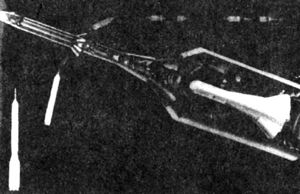 | TKS TKS VA test payload configuration |
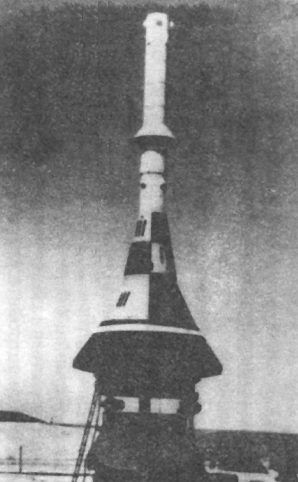 | TKS TKS LES Test |
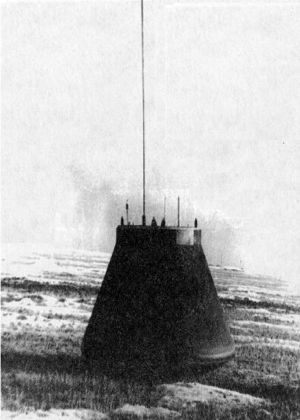 | TKS TKS landed configuration |
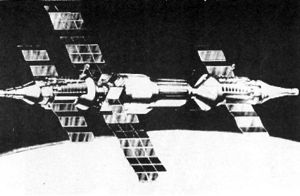 | TKS TKS/Almaz/TKS docked together |
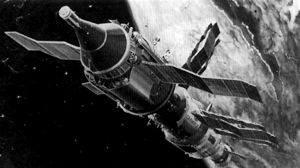 | Kosmos 1267/Salyut 7 Kosmos 1267 / Salyut 7. This detailed painting was the first revelation in the West of the configuration of the TKS spacecraft. |
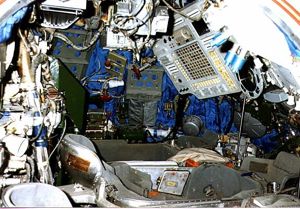 | TKS VA interior TKS VA interior - Chelomei School, Leninsk Credit: © Mark Wade |
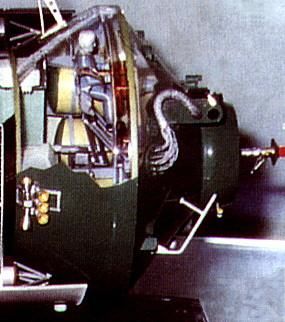 | TKS model TKS model. Close-up of docking system at base. Credit: © Dietrich Haeseler |
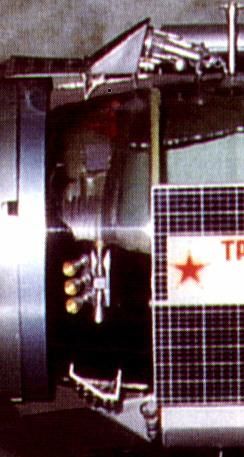 | TKS model TKS model. Close-up of main manoeuvre engines (in triangular housings top and bottom) and reaction control system engine cluster. Credit: © Dietrich Haeseler |
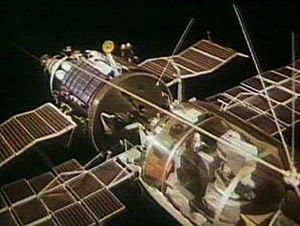 | TKS/Almaz Model |
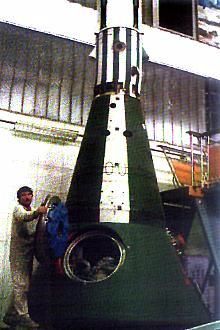 | TKS capsule TKS capsule at Khrunichev factory. Credit: Khrunichev |
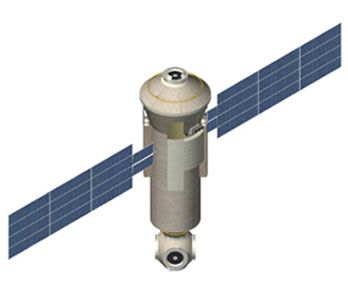 | DSM Credit: Manufacturer Image |
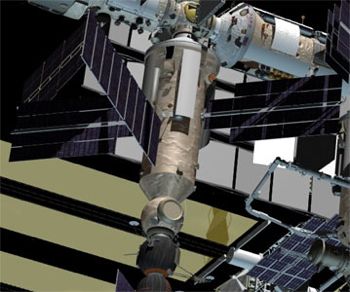 | RM-1; RMS Credit: Manufacturer Image |
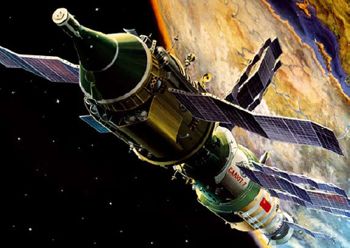 | TKS Credit: Manufacturer Image |
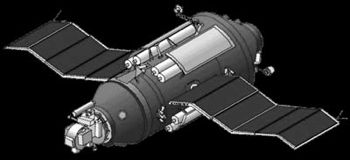 | Cosmos 1686 Credit: Manufacturer Image |
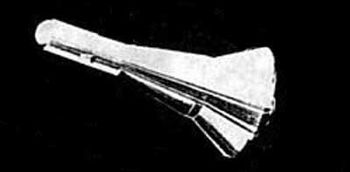 | TKS-VA Credit: Manufacturer Image |
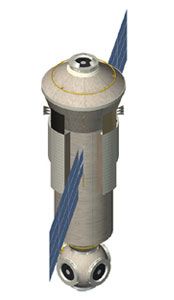 | UDM Credit: Manufacturer Image |
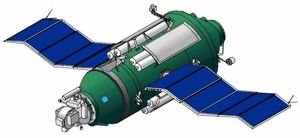 | Cos1663D TKS - Cosmos 1663 Configuration. The recovery systems of the VA capsule were replaced with military space sensors. Credit: © Reginaldo Miranda Jr |
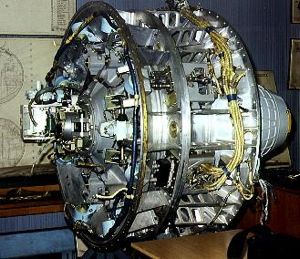 | TKS Docking Mechanis MAI, March 1994 Credit: © Dietrich Haeseler |
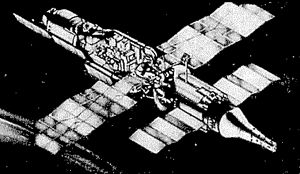 | Almaz OPS-4 Unique view of Almaz OPS-4 with Mech-A radar and Soyuz docking port forward, and TKS docked aft. |
1962 During the Year - . Launch Vehicle: UR-700.
- UR-700 launch vehicle for manned lunar landing missions. - .
Nation: Russia.
Related Persons: Chelomei.
Spacecraft Bus: TKS.
Spacecraft: LK-700.
Chelomei's TsKBM began work on the UR-700. The conclusion was reached that a direct lunar landing would require a payload of 130 to 170 tonnes. Initial LK-700 spacecraft designs were derived from the 'Raketoplan' family of manned modular space vehicles. Korolev's N1-L3 design was selected in 1964 for the manned lunar landing, but the UR-700 would surface again when the N1 encountered delays.
1962 During the Year - . Launch Vehicle: UR-700.
- Development of RD-270 engine begun - .
Nation: Russia.
Related Persons: Chelomei,
Yangel.
Program: Lunar L3.
Class: Moon.
Type: Manned lunar spacecraft. Spacecraft Bus: TKS.
Spacecraft: LK-700.
The RD-270 engine was proposed for Chelomei's UR-700 and Yangel R-56 lunar landing launchers in competition to Korolev N1. The RD-270 was in the same class as the F-1 engine developed for America's Saturn V launch vehicle, but burned storable but toxic propellants.
1962 April 24 - . Launch Vehicle: Proton.
- Approval to proceed with the UR-500 (8K82) was provided in a Central Committee decree - .
Nation: Russia.
Spacecraft Bus: TKS.
Spacecraft: LK-1.
Council of Soviet Ministers (SM) Decree 'On start of work on the UR-500 missile and carrier-rocket' was issued. The rocket was to be built initially for the GR-2 requirement - a heavy rocket that could be used to launch large military payloads into space as well as act as a ballistic missile for multiple nuclear warheads up to 100 MT in yield. The decree ordered development of this powerful new rocket to be completed within three years. This was a difficult task, considering the factory and launch facilities that would have to be built to allow testing of the rocket to begin. The draft project UR-500 was completed in 1963.
1964 October 31 - . Launch Vehicle: UR-700.
- UR-700 project cancelled - .
Nation: Russia.
Related Persons: Chelomei,
Korolev.
Program: Lunar L3.
Class: Moon.
Type: Manned lunar spacecraft. Spacecraft Bus: TKS.
Spacecraft: LK-700.
Following the August decree that gave the circumlunar project to Chelomei and the lunar landing project to Korolev, further work on development of the UR-700 by Chelomei was cancelled. However development of the RD-270 engine was continued and Chelomei continued to do UR-700 design studies.
1965 August 16 - .
- Chelomei's lunar spacecraft attacked - .
Nation: Russia.
Related Persons: Chelomei,
Korolev.
Program: Lunar L1.
Spacecraft Bus: TKS.
Spacecraft: LK-1.
Korolev discusses Chelomei's manned lunar flyby spacecraft with Kamanin. The Party ordered Chelomei to have 12 manned circumlunar spacecraft completed during 1966 and the first quarter of 1967. Chelomei has worked on the he project for many years, but his bureau has not yet decided on a single firm design for the spacecraft, let alone start construction.
1965 October 20 - . Launch Vehicle: UR-700.
- Draft project work on UR-700/LK-700 approved. - . Nation: Russia. Spacecraft Bus: TKS. Spacecraft: LK-700. Ministry of General Machine Building (MOM) Decree 'On approval of work on the draft project of the UR-700/LK-700 lunar complex' was issued..
1967 July 21 - . Launch Vehicle: UR-700.
- Chelomei signs design documents for UR-700/LK-700 lunar expedition - . Nation: Russia. Related Persons: Chelomei. Spacecraft Bus: TKS. Spacecraft: LK-700. Chelomei's TsKBM began work on the UR-700 launch vehicle for manned lunar landing missions in 1962. Chelomei took a sound conservative design approach (i.e. no docking required, no cryogenics)..
1967 September 17 - . Launch Vehicle: UR-700.
- LK-700 manned lunar landing spacecraft authorised - .
Nation: Russia.
Spacecraft Bus: TKS.
Spacecraft: LK-700.
Development of the LK-700 manned lunar landing spacecraft was undertaken in accordance with decree 1070-363 of the Soviet Ministers and Central Committee of the Communist Party on 17 September 1967 and MOM decree 472 of 28 September 1967. Study index number 4855CC by TsNIIMASH in 1966 showed that any development of improved versions of the N1 would be practically equivalent to design and qualification of a new rocket, while the UR-700 modular approach allowed a range of payloads without requalification. The UR-700/LK-700 combination could support the DLB lunar base better, as well as Venus/Mars manned flybys and Mars landing expeditions. Work would continue through the mock-up stage until 1974.
1970 June 16 - . LV Family: Proton. Launch Vehicle: Proton-K.
- Development of TKS ferry for Almaz authorised. Soyuz 7K-TK cancelled - .
Nation: Russia.
Related Persons: Chelomei.
Spacecraft: Soyuz 7K-TK,
TKS.
Decree 437-160 'On creation of the TKS and termination of the 7K-TK' was issued. In 1969 Chelomei proposed replacement of the 11F72 Soyuz 7K-TK with his own transport-supply spacecraft 11F72 (transportnovo korablya snabzheniya - TKS). This would consist of the same 11F74 VA landing capsule used on the Almaz station, together with a new 11F77 functional-cargo block (funktsionalno-gruzovovo blok, FGB). This would transport three crew and sufficient supplies for 90 day operation of the Almaz.
1970 December 31 - . Launch Vehicle: UR-700.
- UR 700/LK-700/RD-270 definitively cancelled. - . Nation: Russia. Program: Lunar L3. Class: Moon. Type: Manned lunar spacecraft. Spacecraft Bus: TKS. Spacecraft: LK-700. Further development work on the RD-270 engine, UR-700 launch vehicle, and LK-700 lunar landing project are cancelled following the successful Apollo lunar landing..
1971 March 6 - .
- Space Plan for 1971 unrealistic. - .
Nation: Russia.
Program: Salyut,
Almaz.
Flight: Soyuz 10,
Soyuz 11,
Soyuz 12 / DOS 1.
Spacecraft: Almaz OPS,
Salyut 1,
Spiral OS,
TKS.
The space plan for 1971 has finally been approved. There are to be three space stations launched, manned by ten Soyuz launches and a total of over 12 different crewmembers in space during the year. But it is clear to Kamanin that the second DOS and first Almaz station will not really be ready this year. And there won't be more than two Soyuz and two TKS transports available by the end of the year. Ranazomov says that Chelomei's TKS, being designed to fly to the Almaz, will cover many of he same requirements of the Spiral spaceplane. He proposes that Mikoyan should collaborate with Chelomei on Spiral. Meanwhile simulators at TsPK remain underfunded.
1972 June 15 - . LV Family: Proton. Launch Vehicle: Proton-K.
- Almaz / TKS project rescheduled. - . Nation: Russia. Spacecraft: Almaz OPS, Almaz OPS-2, TKS. Ministry of General Machine Building (MOM) Decree 'On schedule of work for the Almaz and TKS programs' was issued..
1976 January 19 - .
- Almaz / TKS flight tests approved. - . Nation: Russia. Spacecraft: Almaz OPS, Almaz OPS-2, TKS. Central Committee of the Communist Party and Council of Soviet Ministers Decree 46-13 'On course of work on Almaz and the TKS' was issued..
1976 December 15 - . 01:30 GMT - . Launch Site: Baikonur. Launch Complex: Baikonur LC81/24. LV Family: Proton. Launch Vehicle: Proton-K.
- Cosmos 881 - .
Payload: TKS VA s/n 009P. Mass: 4,250 kg (9,360 lb). Nation: Russia.
Agency: MOM.
Program: Almaz.
Class: Manned.
Type: Manned spacecraft. Spacecraft Bus: TKS.
Spacecraft: TKS VA .
Duration: 0.0600 days. Decay Date: 1976-12-15 . USAF Sat Cat: 9606 . COSPAR: 1976-121A. Apogee: 241 km (149 mi). Perigee: 201 km (124 mi). Inclination: 51.60 deg. Period: 88.90 min.
Launch of mission LVI-1 came at 04:00 on 15 December. At 176 seconds the ADU escape tower separated from the LVI. Once the final stage had shut down in orbit, by command from the launch vehicle sequencer, the VA 009A (also given as 009P) and its TDU separated from the LVI. Two seconds later VA 009 (or 009L) was ejected. Fifteen minutes after launch all systems of the both VA capsules were in operation. The guidance system detected the direction of flight and oriented each spacecraft for retro-fire, and the pair began the return to earth after less than one revolution. At an external atmospheric pressure of 165 mm (10 km altitude) the NO section jettisoned, the three-cupola drogue parachute ejected, and the antennae and altimeter were deployed. The Komara landing radio beacon (installed on the landing section of the parachute) was activated when the spacecraft was 1.0 to 1.5 m above the ground - which occurred at the same moment on both 009 and 009A. The Kaktus special system tripped the soft landing PRSP (parachute landing propulsion system). The soft landing was accomplished with higher accuracy than Soyuz, both capsules being recovered at 44 deg N, 73 deg E, on December 15, 1976 3:00 GMT. The flights were officially given the designations Cosmos 881 (VA 009A) and Cosmos 882 (VA 009). US intelligence believed them to be tests of recoverable manned spaceplane prototypes.
- Cosmos 882 - . Payload: TKS VA s/n 009L. Mass: 4,250 kg (9,360 lb). Nation: Russia. Agency: MOM. Program: Almaz. Class: Manned. Type: Manned spacecraft. Spacecraft Bus: TKS. Spacecraft: TKS VA. Decay Date: 1976-12-15 . USAF Sat Cat: 9607 . COSPAR: 1976-121B. Apogee: 213 km (132 mi). Perigee: 191 km (118 mi). Inclination: 51.60 deg. Period: 88.50 min. Test of TKS-VA capsule. Two satellites launched by a single rocket..
1977 July 17 - . 09:00 GMT - . Launch Site: Baikonur. Launch Complex: Baikonur LC81/24. LV Family: Proton. Launch Vehicle: Proton-K.
- Cosmos 929 - .
Payload: TKS s/n 16101. Mass: 19,000 kg (41,000 lb). Nation: Russia.
Agency: MOM.
Program: Almaz.
Class: Manned.
Type: Manned spacecraft. Spacecraft: TKS .
Duration: 199.62 days. Decay Date: 1978-02-02 . USAF Sat Cat: 10146 . COSPAR: 1977-066A. Apogee: 260 km (160 mi). Perigee: 226 km (140 mi). Inclination: 51.60 deg. Period: 89.40 min.
First test of TKS manned shuttle. Maneuvered extensively. TKS-VA capsule returned to earth August 16, 1977. Deorbited February 2, 1978.
Maneuver Summary:
214 km X 261 km orbit to 215 km X 279 km orbit. Delta V: 5 m/s
207 km X 261 km orbit to 208 km X 264 km orbit. Delta V: 1 m/s
208 km X 260 km orbit to 209 km X 267 km orbit. Delta V: 2 m/s
192 km X 222 km orbit to 219 km X 232 km orbit. Delta V: 9 m/s
219 km X 232 km orbit to 303 km X 327 km orbit. Delta V: 51 m/s
303 km X 327 km orbit to 312 km X 318 km orbit. Delta V: 4 m/s
312 km X 319 km orbit to 314 km X 325 km orbit. Delta V: 1 m/s
284 km X 294 km orbit to 290 km X 301 km orbit. Delta V: 3 m/s
288 km X 300 km orbit to 286 km X 305 km orbit. Delta V: 1 m/s
285 km X 303 km orbit to 439 km X 447 km orbit. Delta V: 84 m/s
437 km X 448 km orbit to 335 km X 437 km orbit. Delta V: 31 m/s
335 km X 437 km orbit to 337 km X 438 km orbit. Delta V: 1 m/s
337 km X 438 km orbit to 90 km X 337 km orbit. Delta V: 100 m/s
Total Delta V: 193/293 m/s
Officially: Investigation of the upper atmosphere and outer space.
1977 August 4 - . 22:00 GMT - . Launch Site: Baikonur. Launch Complex: Baikonur LC81/24. LV Family: Proton. Launch Vehicle: Proton-K. FAILURE: First stage engine steering unit failure at T+40.1 seconds. Failed Stage: 1.
- TKS VA s/n 009L/P - . Payload: TKS VA s/n 009L/P. Mass: 4,250 kg (9,360 lb). Nation: Russia. Agency: RVSN. Program: Almaz. Class: Manned. Type: Manned spacecraft. Spacecraft Bus: TKS. Spacecraft: TKS VA. Decay Date: 1977-08-04 . Spacecraft lost in booster explosion..
- TKS VA s/n 009P/P - .
Payload: TKS VA s/n 009P/P. Mass: 3,800 kg (8,300 lb). Nation: Russia.
Agency: RVSN.
Program: Almaz.
Spacecraft Bus: TKS.
Spacecraft: TKS VA.
A repeat test of the VA capsules from LVI-1 of a month earlier were atop the Proton (VA's 009P and 009L). However the booster failed at 49 seconds after launch. The SAS launch escape system pulled the top capsule (009P) away from the exploding Proton rocket and it was successfully recovered. The lower capsule was lost with the booster.
1978 - During the year - .
- Manned Almaz program terminated - .
Nation: Russia.
Related Persons: Chelomei,
Glushko,
Ustinov.
Program: Almaz.
Class: Manned.
Type: Manned space station. Spacecraft: Almaz OPS-2,
TKS.
Almaz station portion of the project already severely cut back after Marshal Grechko's heart attack in early 1976. Chelomei lost his most active patron and was unable to withstand the slow strangulation of his projects by Ustinov and Glushko. Almaz finally completely scrapped in 1980, but Chelomei hid the completed space stations in a corner of his complex, labelling them as 'radioactive material'. Chelomei finally forced to retire in October 1983. TKS shuttle craft used to dock with Salyut stations but never in manned mode. Following Ustinov's death, Almaz stations finally flown as unmanned radarsats, but Chelomei did not live to see this.
1978 March 30 - . 00:00 GMT - . Launch Site: Baikonur. Launch Complex: Baikonur LC81/24. Launch Pad: LC81/24?. LV Family: Proton. Launch Vehicle: Proton-K.
- Cosmos 997 - .
Payload: TKS VA s/n 102L. Mass: 4,250 kg (9,360 lb). Nation: Russia.
Agency: MOM.
Program: Almaz.
Class: Manned.
Type: Manned spacecraft. Flight: Cosmos 997.
Spacecraft Bus: TKS.
Spacecraft: TKS VA .
Decay Date: 1978-03-30 . USAF Sat Cat: 10770 . COSPAR: 1978-032A. Apogee: 230 km (140 mi). Perigee: 200 km (120 mi). Inclination: 51.60 deg. Period: 88.70 min.
Given the on-pad explosion of the LVI-2 launch attempt, plans to crew the upper VA re-entry capsule in the next test was abandoned. LVI-3 (VA's 102P and 102L / Cosmos 997 and Cosmos 998) was launched unmanned four months behind the original schedule. Both capsules were recovered after one orbit. One source indicates that one of the capsules was 009P, on its third launch and second flight to orbit. This was said to have demonstrated the multiple re-entry capability of the heat shield and the first planned reuse of a spacecraft (Gemini 2 was refurbished and reflown as MOL-1 in the 1960's, but was not designed for that purpose).
- Cosmos 998 - . Payload: TKS VA s/n 102P. Mass: 4,250 kg (9,360 lb). Nation: Russia. Agency: MOM. Program: Almaz. Class: Manned. Type: Manned spacecraft. Spacecraft Bus: TKS. Spacecraft: TKS VA. Decay Date: 1978-03-30 . USAF Sat Cat: 10771 . COSPAR: 1978-032B. Apogee: 230 km (140 mi). Perigee: 200 km (120 mi). Inclination: 51.60 deg. Period: 88.70 min. Dual reentry test of two TKS-VA capsules. Recovered March 30, 1978 after one orbit..
1979 February - .
- Almaz cancelled and consolidated with Mir - .
Nation: Russia.
Related Persons: Chelomei.
Spacecraft: Almaz OPS-2,
Mir,
TKS.
Following the decision to cancel Chelomei's manned Almaz military space station programme, a resolution consolidated the programs, with the Mir docking ports to be reinforced to accommodate 20 tonne space station modules based on Chelomei's TKS manned ferry spacecraft. NPO Energia was made responsible for the overall space station, but subcontracted the work to KB Salyut due to the press of in-house work on Energia, Salyut 7, Soyuz-T, and Progress. The subcontractor began work in the summer of 1979.
1979 April 20 - . Launch Site: Baikonur. Launch Complex: Baikonur LC81/24.
- TKS VA s/n 008 - .
Payload: TKS VA s/n 008. Mass: 4,250 kg (9,360 lb). Nation: Russia.
Program: Almaz.
Class: Manned.
Type: Manned spacecraft. Flight: TKS VA s/n 008.
Spacecraft Bus: TKS.
Spacecraft: TKS VA .
On 20 April 1979 LVI-4 VA (VA s/n 103 and s/n 008) was awaiting launch. The booster ignited, but then shut down on the pad. This triggered the launch escape system, which pulled the top capsule away from the booster. The parachute system failed and the capsule crashed to the ground. The lower capsule remained in the rocket. The top capsule was to have been manned, but the inability to demonstrate two consecutive failure-free launches of the Proton/TKS-VA combination made that (luckily) impossible.
1979 April 20 - .
- TKS VA s/n 103 - . Payload: TKS VA s/n 103. Mass: 4,250 kg (9,360 lb). Nation: Russia. Program: Almaz. Class: Manned. Type: Manned spacecraft. Spacecraft Bus: TKS. Spacecraft: TKS VA .
1979 April 20 - . Launch Site: Baikonur. Launch Complex: Baikonur LC81/24. LV Family: Proton. Launch Vehicle: Proton-K. FAILURE: Engines ignited but immediately shut down on launch pad. Booster could be reused with new payload.. Failed Stage: 1.
- Payload: TKS VA s/n 008. Nation: Russia. Program: Almaz. Class: Manned. Type: Manned spacecraft. Spacecraft Bus: TKS. Spacecraft: TKS VA . Decay Date: 1979-05-23 . USAF Sat Cat: 11362 . Apogee: 223 km (138 mi). Perigee: 193 km (119 mi). Inclination: 51.60 deg. Period: 88.70 min.
1979 May 22 - . 23:00 GMT - . Launch Site: Baikonur. Launch Complex: Baikonur LC81/24. LV Family: Proton. Launch Vehicle: Proton-K.
- Cosmos 1100 - .
Payload: TKS VA s/n 102P. Mass: 4,250 kg (9,360 lb). Nation: Russia.
Agency: MOM.
Program: Almaz.
Class: Manned.
Type: Manned spacecraft. Flight: Cosmos 1100.
Spacecraft Bus: TKS.
Spacecraft: TKS VA .
Duration: 0.0600 days. Decay Date: 1979-05-23 . USAF Sat Cat: 11362 . COSPAR: 1979-042A. Apogee: 222 km (137 mi). Perigee: 193 km (119 mi). Inclination: 51.60 deg. Period: 88.60 min.
The Proton launch vehicle that shut down on the original LVI-4 launch attempt was undamaged, and just a month later, with a switch of payload, LVI-4 was orbited as Cosmos 1100 and 1101. The pair launched were the 102P/102L twins from LVI-3. One capsule failed when the automatic system suffered an electrical distribution failure and it did not land correctly, spending two orbits in space, while the other landed as planned after one orbit. The launch again successfully demonstrated the reusability of the VA capsule. Plans to launch the upper capsule manned were scrubbed due to the inability to get two consecutive failure-free launches of the Proton/TKS-VA.
- Cosmos 1101 - . Payload: TKS VA s/n 102L. Mass: 4,250 kg (9,360 lb). Nation: Russia. Agency: MOM. Program: Almaz. Class: Manned. Type: Manned spacecraft. Spacecraft Bus: TKS. Spacecraft: TKS VA. Decay Date: 1979-05-23 . USAF Sat Cat: 11363 . COSPAR: 1979-042B. Apogee: 222 km (137 mi). Perigee: 193 km (119 mi). Inclination: 51.60 deg. Period: 88.60 min. Test of TKS-VA manned capsule. Two satellites launched by a single rocket..
1981 Beginning of - .
- TKS-1 (cancelled) - .
Crew: Berezovoi,
Glazkov,
Makrushin.
Backup Crew: Artyukhin,
Kozelsky,
Romanov.
Nation: Russia.
Program: Almaz.
Flight: TKS-1.
Spacecraft: TKS.
Planned first test manned flight of the TKS large ferry craft. Would have docked with the Almaz OPS 4 military space station. Flight cancelled with the rest of the Almaz program in 1981. The spacecraft was instead flown unmanned to Salyut 6 as Cosmos 1267.
1981 Middle of - .
- TKS-2 (cancelled) - . Crew: Artyukhin, Kozelsky, Romanov. Backup Crew: Preobrazhensky, Sarafanov, Yuyukov. Nation: Russia. Program: Almaz. Flight: TKS-2. Spacecraft: TKS. Second TKS flight that would have docked with the cancelled Almaz OPS 4 military space station. The spacecraft was instead flown unmanned to Salyut 7 as Cosmos 1443..
1981 April 25 - . 02:01 GMT - . Launch Site: Baikonur. Launch Complex: Baikonur LC200/39. LV Family: Proton. Launch Vehicle: Proton-K.
- Cosmos 1267 - .
Payload: TKS s/n 16301. Mass: 19,000 kg (41,000 lb). Nation: Russia.
Agency: MOM.
Program: Almaz.
Class: Manned.
Type: Manned spacecraft. Spacecraft: TKS .
Duration: 459.91 days. Decay Date: 1982-07-29 . USAF Sat Cat: 12419 . COSPAR: 1981-039A. Apogee: 259 km (160 mi). Perigee: 192 km (119 mi). Inclination: 51.60 deg. Period: 88.90 min.
TKS space station ferry. Flown unmanned to the Salyut 6 space station after the Almaz military station program was cancelled. Capsule recovered 24 May 1981. Docked with Salyut 6 on June 19 at 10:52 AM MT after 57 days autonomous flight. Deorbited and destroyed with Salyut July 29, 1982. Additional Details: here....
1981 Late - .
- TKS-3 (cancelled) - . Crew: Preobrazhensky, Sarafanov, Yuyukov. Backup Crew: Grechanik, Rozhdestvensky, Vasyutin. Nation: Russia. Program: Almaz. Flight: TKS-3. Spacecraft: TKS. Third TKS flight that would have docked with the cancelled Almaz OPS 4 military space station. The spacecraft was instead flown unmanned to Salyut 7 as Cosmos 1686..
1983 March 2 - . 09:37 GMT - . Launch Site: Baikonur. Launch Complex: Baikonur LC200/39. LV Family: Proton. Launch Vehicle: Proton-K.
- Cosmos 1443 - .
Payload: TKS-M s/n 16401L. Mass: 20,000 kg (44,000 lb). Nation: Russia.
Agency: MOM.
Program: Almaz.
Class: Manned.
Type: Manned spacecraft. Spacecraft: TKS .
Duration: 200.62 days. Decay Date: 1983-09-19 . USAF Sat Cat: 13868 . COSPAR: 1983-013A. Apogee: 261 km (162 mi). Perigee: 194 km (120 mi). Inclination: 51.60 deg. Period: 89.00 min.
TKS manned ferry spacecraft from the cancelled Almaz OPS-4 mission. Flown unmanned to the Salyut 7 space station. Docked with Salyut 7 on 4 March 1983. Separated from Salyut 7 on 14 August. The VA re-entry capsule separated and the space station deorbited itself on September 19, 1983 at 0:28 GMT. The VA capsule continued in space for four more days, demonstrating autonomous flight, before successfully re-entering on 23 August 1983. Returned 350 kg of material from the station. Additional Details: here....
1985 September 27 - . 08:41 GMT - . Launch Site: Baikonur. Launch Complex: Baikonur LC200/39. LV Family: Proton. Launch Vehicle: Proton-K.
- Cosmos 1686 - .
Payload: TKS-M s/n 16501. Mass: 20,000 kg (44,000 lb). Nation: Russia.
Agency: MOM.
Program: Almaz.
Class: Manned.
Type: Manned spacecraft. Flight: Soyuz T-13 EO-4-a,
Soyuz T-14 EO-4-c.
Spacecraft: TKS .
Duration: 1,958.80 days. Decay Date: 1991-02-07 . USAF Sat Cat: 16095 . COSPAR: 1985-086A. Apogee: 284 km (176 mi). Perigee: 280 km (170 mi). Inclination: 51.60 deg. Period: 90.20 min.
Modification of cancelled TKS manned ferry; docked with Salyut 7. All landing systems were removed from the VA re-entry capsule and replaced with military optical sensor experiments (infrared telescope and Ozon spectrometer). Burned up in the atmosphere and together with the Salyut 7 station over Argentina on February 7, 1991 04:00 GMT. Re-entered with unused 3 m diameter recoverable capsule of 2-3,000 kg mass, solid rocket motors, and cesium sensors.
Maneuver Summary:
172 km X 302 km orbit to 284 km X 319 km orbit. Delta V: 36 m/s
281 km X 315 km orbit to 290 km X 336 km orbit. Delta V: 8 m/s
290 km X 336 km orbit to 335 km X 352 km orbit. Delta V: 16 m/s
Maneuvers after docking with Salyut 7:
336 km X 353 km orbit to 338 km X 358 km orbit. Delta V: 1 m/s
338 km X 358 km orbit to 358 km X 359 km orbit. Delta V: 5 m/s
331 km X 333 km orbit to 333 km X 385 km orbit. Delta V: 14 m/s
333 km X 385 km orbit to 332 km X 468 km orbit. Delta V: 23 m/s
332 km X 468 km orbit to 466 km X 468 km orbit. Delta V: 37 m/s
466 km X 468 km orbit to 470 km X 475 km orbit. Delta V: 2 m/s
470 km X 475 km orbit to 475 km X 475 km orbit. Delta V: 1 m/s
Total Delta V: 143 m/s
Officially: Testing the equipment, assemblies and design components of a satellite in various modes of flight, including joint flight with the Salyut-7 station.
1986 July - . LV Family: Buran. Launch Vehicle: Energia.
- Polyus mock-up delivered to Baikonur - . Nation: Russia. Spacecraft Bus: TKS. Spacecraft: Polyus. A Polyus mock-up was delivered by the Krunichev Factory to Baikonur Cosmodrome, for tests of the Polyus/Energia interface. The spacecraft was about 37 meters in length, 4.1 meters in diameter and weighed about 80 metric tons..
1987 May 15 - . 17:30 GMT - . Launch Site: Baikonur. Launch Complex: Baikonur LC250. LV Family: Buran. Launch Vehicle: Energia. FAILURE: No orbital insertion due to failure of the FGB attitude control system (Energia performed perfectly). Partial Failure.. Failed Stage: P.
- Polyus - .
Payload: Skif-DM. Mass: 80,000 kg (176,000 lb). Nation: Russia.
Agency: UNKS.
Program: Buran.
Class: Military.
Type: Strategic defense satellite. Spacecraft Bus: TKS.
Spacecraft: Polyus.
Decay Date: 1987-05-15 . COSPAR: F870515A.
Due to delays in completion of the enormous static test facility at Baikonur, which could test the entire Energia vehicle stack, it was decided to launch the vehicle without the verification the tests would provide. The launch of 6SL was planned for 11 May 1987 at 21:30 Moscow time. It was delayed five days when a leak was detected in the Block 3A electrical distribution section, then by another hour due to a fault LH2 thermostat. The launch vehicle performed successfully, but the Polyus payload failed to inject itself into orbit due to a guidance system failure. Additional Details: here....
Back to top of page
Home - Search - Browse - Alphabetic Index: 0- 1- 2- 3- 4- 5- 6- 7- 8- 9
A- B- C- D- E- F- G- H- I- J- K- L- M- N- O- P- Q- R- S- T- U- V- W- X- Y- Z
© 1997-2019 Mark Wade - Contact
© / Conditions for Use
